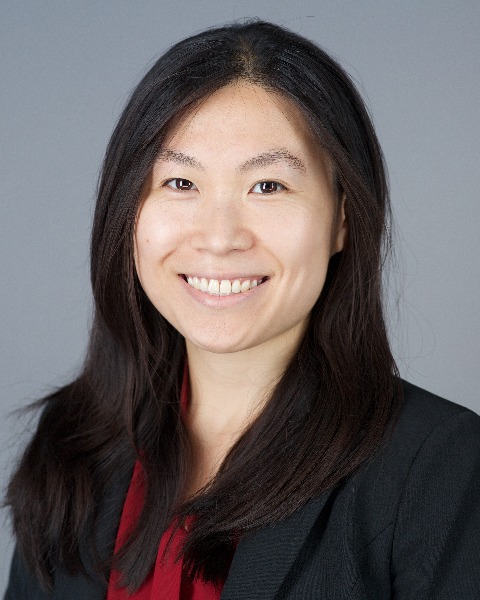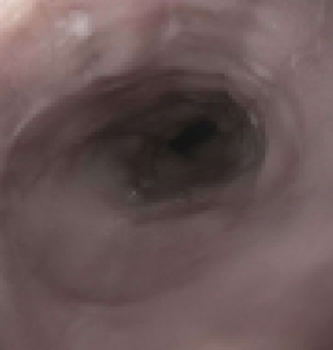Sunday Poster Session
Category: Esophagus
P0704 - Eosinophilic Esophagitis Diagnosed in Late Adulthood Following a Prolonged History of GERD
Sunday, October 26, 2025
3:30 PM - 7:00 PM PDT
Location: Exhibit Hall

Amy Yeung, DO (she/her/hers)
Valley Health System, Icahn School of Medicine at Mount Sinai
Paramus, NJ
Presenting Author(s)
Amy Yeung, DO1, Shreya Bollu, BA2, Michael Rahmin, MD1, Metin Taskin, MD1, Sita Chokhavatia, MD, MACG1
1Valley Health System, Icahn School of Medicine at Mount Sinai, Paramus, NJ; 2Saint Louis University, St. Louis, MO
Introduction: Eosinophilic esophagitis (EoE) is a chronic, immune-mediated inflammatory disease of the esophagus that can cause symptoms of dysphagia, food impaction, heartburn, and regurgitation. While commonly diagnosed in younger patients, EoE in older adults is frequently misattributed to gastroesophageal reflux disease (GERD) or functional esophageal disorders. We present a case of a 67-year-old man with 40 years of GERD symptoms, whose diagnosis of EoE was delayed until recent symptom progression prompted further re-evaluation with esophageal biopsies and imaging studies.
Case Description/
Methods: A 67-year-old man presented for evaluation of chronic GERD that had been present for four decades. For the past year, he developed difficulty swallowing solid foods, particularly steak, with episodes initially localized to the mid-cervical region and the mid-retrosternal area. His symptoms had progressed, with one episode involving a sensation of food lodged in the retrosternal area that resolved after drinking water that enabled aboral progression of the food bolus. An esophagogastroduodenoscopy (EGD) was reported to be normal. Due to multiple negative prior endoscopic evaluations, the patient was considered to have functional heartburn or esophageal dysmotility and referred for further evaluation.
An EGD was repeated and now revealed a narrowed esophageal lumen and subtle linear furrows and mucosal changes (Figure 1a); biopsies demonstrated ≥ 30 eosinophils per high-power field in both mid and distal esophagus (Figure 1b). A follow-up barium esophagogram confirmed a narrow-caliber esophagus with delayed bolus transit. The patient was diagnosed with EoE and had significant improvement on a proton-pump inhibitor and an elimination diet.
Discussion: This case highlights the potential for delayed diagnosis of EoE in older adults, particularly when symptoms are attributed to functional or reflux-related etiologies. Earlier consideration of EoE, may prevent delayed diagnosis and complications such as strictures and food impaction. This case reinforces the importance of maintaining a broad differential in chronic GERD and supports obtaining esophageal biopsies even when endoscopic findings appear grossly normal in patients with dysphagia symptoms.

Figure: Figure 1a: Lower third of esophagus showing longitudinal furrows, white plaques, and circumferential folds.

Figure: Figure 1b: 400X hematoxylin-eosin stain showing markedly increased eosinophils in squamous mucosa.
Disclosures:
Amy Yeung indicated no relevant financial relationships.
Shreya Bollu indicated no relevant financial relationships.
Michael Rahmin indicated no relevant financial relationships.
Metin Taskin indicated no relevant financial relationships.
Sita Chokhavatia indicated no relevant financial relationships.
Amy Yeung, DO1, Shreya Bollu, BA2, Michael Rahmin, MD1, Metin Taskin, MD1, Sita Chokhavatia, MD, MACG1. P0704 - Eosinophilic Esophagitis Diagnosed in Late Adulthood Following a Prolonged History of GERD, ACG 2025 Annual Scientific Meeting Abstracts. Phoenix, AZ: American College of Gastroenterology.
1Valley Health System, Icahn School of Medicine at Mount Sinai, Paramus, NJ; 2Saint Louis University, St. Louis, MO
Introduction: Eosinophilic esophagitis (EoE) is a chronic, immune-mediated inflammatory disease of the esophagus that can cause symptoms of dysphagia, food impaction, heartburn, and regurgitation. While commonly diagnosed in younger patients, EoE in older adults is frequently misattributed to gastroesophageal reflux disease (GERD) or functional esophageal disorders. We present a case of a 67-year-old man with 40 years of GERD symptoms, whose diagnosis of EoE was delayed until recent symptom progression prompted further re-evaluation with esophageal biopsies and imaging studies.
Case Description/
Methods: A 67-year-old man presented for evaluation of chronic GERD that had been present for four decades. For the past year, he developed difficulty swallowing solid foods, particularly steak, with episodes initially localized to the mid-cervical region and the mid-retrosternal area. His symptoms had progressed, with one episode involving a sensation of food lodged in the retrosternal area that resolved after drinking water that enabled aboral progression of the food bolus. An esophagogastroduodenoscopy (EGD) was reported to be normal. Due to multiple negative prior endoscopic evaluations, the patient was considered to have functional heartburn or esophageal dysmotility and referred for further evaluation.
An EGD was repeated and now revealed a narrowed esophageal lumen and subtle linear furrows and mucosal changes (Figure 1a); biopsies demonstrated ≥ 30 eosinophils per high-power field in both mid and distal esophagus (Figure 1b). A follow-up barium esophagogram confirmed a narrow-caliber esophagus with delayed bolus transit. The patient was diagnosed with EoE and had significant improvement on a proton-pump inhibitor and an elimination diet.
Discussion: This case highlights the potential for delayed diagnosis of EoE in older adults, particularly when symptoms are attributed to functional or reflux-related etiologies. Earlier consideration of EoE, may prevent delayed diagnosis and complications such as strictures and food impaction. This case reinforces the importance of maintaining a broad differential in chronic GERD and supports obtaining esophageal biopsies even when endoscopic findings appear grossly normal in patients with dysphagia symptoms.

Figure: Figure 1a: Lower third of esophagus showing longitudinal furrows, white plaques, and circumferential folds.

Figure: Figure 1b: 400X hematoxylin-eosin stain showing markedly increased eosinophils in squamous mucosa.
Disclosures:
Amy Yeung indicated no relevant financial relationships.
Shreya Bollu indicated no relevant financial relationships.
Michael Rahmin indicated no relevant financial relationships.
Metin Taskin indicated no relevant financial relationships.
Sita Chokhavatia indicated no relevant financial relationships.
Amy Yeung, DO1, Shreya Bollu, BA2, Michael Rahmin, MD1, Metin Taskin, MD1, Sita Chokhavatia, MD, MACG1. P0704 - Eosinophilic Esophagitis Diagnosed in Late Adulthood Following a Prolonged History of GERD, ACG 2025 Annual Scientific Meeting Abstracts. Phoenix, AZ: American College of Gastroenterology.
